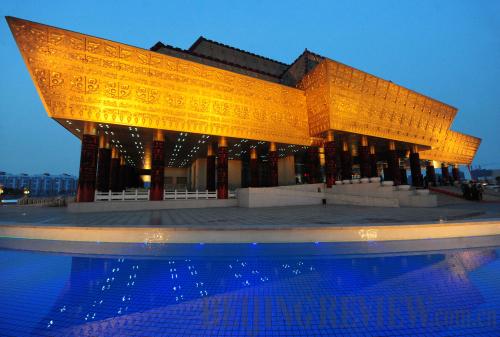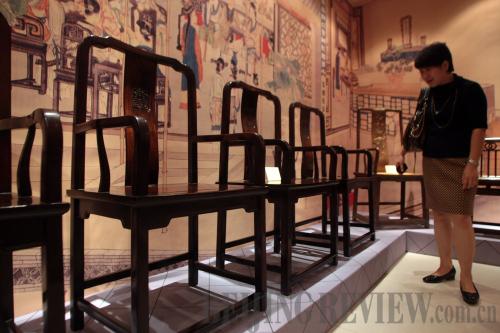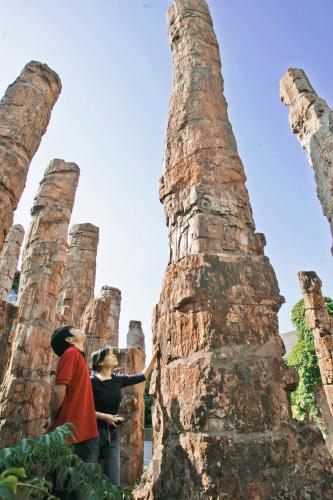|
 |
|
SHINING CULTURE: The National Museum of Chinese Characters, the only of its kind in the world, shows its evening elegance in Anyang central China's Henan Province, on November 17, 2009 (WANG SONG) |
The 34th International Museum Day will come on May 18, with the theme of "Museums for Social Harmony."
On April 25-26, a forum about the economy and development of museums was held in Nanchang, capital of central China's Jiangxi Province, discussing the leading role of museums in the economic and cultural development of a city.
The forum was a prelude to the 22nd General Conference of the International Council of Museums (ICOM), which will be held at the World Expo Center in Shanghai on November 7-12, the first time in China.
Over the past decades, China's museums have achieved rapid development and their total number has now reached 2,900, said Song Xinchao, Deputy Director of the State Administration of Cultural Heritage (SACH).
Booming era
 |
|
ANCIENT LIFESTYLE: A visitor examines the antique Chinese furniture exhibited in the Guanfu Museum, a private museum in Beijing (CFP) | Compared with Western countries, China set out much later to build its museums, and the development of museums in the country was slow in the past.
The first public museum of the country, Nantong Museum, was founded in Nantong, a city of east China's Jiangsu Province, in 1905.
In November 1949, China's Ministry of Culture established the Cultural Relics Administrative Bureau, which began management of the 21 museums in the country. Since then, museum administrative authorities at different levels have been gradually established throughout the country.
With the founding of the People's Republic of China in 1949, China's museum industry entered a new development phase.
Especially after the start of the reform and opening up in 1978, with the improvement of China's comprehensive national power, Chinese museums began developing more rapidly.
In addition to museums at the provincial level or above, a great number of city- and county-level museums were established. Meanwhile, many professional and private museums also appeared in China.
In 1955, China's first professional museum, the Yellow River Museum, was built in Zhengzhou, capital of central China's Henan Province. A series of professional museums have been established since then, including a railway museum, film museum, dairy museum, ancient coins museum and water museum.
The China National Film Museum is to date the largest professional museum for films in the world. It was founded in 2005 to celebrate the 100th anniversary of the Chinese film industry. The museum was designed to show the history of Chinese films, to host film technology expos, and to provide a venue for academic exchanges and research, in order to advance film culture both in China and abroad.
 |
|
MUSEUM SCENERY: Visitors watch petrified woods at Tianjin Baocheng Museum Garden, a private museum, on May 18, 2007 (XINHUA) | On March 22, the National Water Museum of China, the first of its kind in the country, was opened in Hangzhou, east China's Zhejiang Province.
On March 26, the Qingdao Wine Museum, China's largest wine museum, was opened to the public in Qingdao, east China's Shandong Province. Built in an old civil air defense engineering, the 8,800-square-meter professional museum introduces the process of grape planting, the history of wine brewing and world famous wineries to visitors.
Also in Shandong Province, the China Shouguang Vegetable Museum, the first of its kind in the country, was established in Shouguang on April 19. The museum shows the relationship between the development of China's vegetable farming and society, and exhibits items such as farming tools, specimens and drawings from the Longshan Civilization Period (2340-1940 B.C.) to modern period.
China has also seen a significant expansion in private museums in recent years.
On October 30, 1996, Ma Weidu, a famous Chinese antique collector, established China's first private museum, the Guanfu Museum in Beijing.
According to statistics of the SACH, China has 386 registered private museums as of 2009 and the number in Beijing has reached 30, although the actual number is uncertain because some private museums are not registered with the administration.
On January 10 this year, the Museum of Imperial Granary of Ming Dynasty (1368-1644) opened in Beijing. The private museum provides opportunities for people to learn about the history of canal transportation and grain storage in imperial granaries in the Ming and Qing (1644-1911) dynasties, as well as to experience the life of being a granary keeper.
On January 9, the Film Legend Museum, China's first private museum devoted to the history of films, was opened in Beijing. The museum was founded by the famous TV talk show host Cui Yongyuan.
"A system of diversified museums has been formed in China," said Song. "Currently, different types of museums are coexisting, including state-owned museums and private ones."
The role of Chinese museums has undergone great changes—from traditional attention to relic preservation and research to current functions such as cultural communication and public education.
The successful acquisition to host the 22nd General Conference of the ICOM demonstrated that the development of Chinese museums had obtained the respect and approval of the international community, said An Laishun, Secretary General of the Chinese Society of Museums.
|
